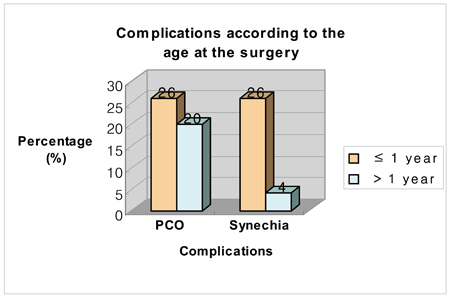Korean J Ophthalmol.
2008 Jun;22(2):87-91. 10.3341/kjo.2008.22.2.87.
Clinical Outcomes of Surgical Techniques in Congenital Cataracts
- Affiliations
-
- 1Department of Ophthalmology, Samsung Medical Center, Sungkyungwan University School of Medicine, Seoul, Korea. tychung@skku.edu
- KMID: 1099001
- DOI: http://doi.org/10.3341/kjo.2008.22.2.87
Abstract
- PURPOSE: To investigate the general clinical features of congenital cataracts and to determine their relationship to visual prognosis and surgical complications according to age at operation and surgical procedure adopted. METHOD: We retrospectively evaluated 92 eyes in 61 patients with congenital cataracts who underwent cataract surgery between January 1996 and December 2006. The demographic data, surgical technique, post-operative complications, and final visual prognosis were evaluated. RESULTS: The average age at surgery was 3.17 years (range 1 month to 11 years), and the mean follow-up was 40.02 months (range 6 to 46 months). Of the 56 eyes that could be checked for visual acuity after cataract extraction, 29 (51.7%) had a BCVA of > or =0.5 at last visit. Unilateral congenital cataracts (p=0.025) and congenital cataracts with strabismus (p=0.019) showed significantly poorer visual outcomes. Patients with nystagmus also experienced a poor visual outcome; 6 patients (67%) had a BCVA of <0.1. Posterior cataracts had the worst visual prognosis (p=0.004). No statistically significant differences in posterior capsular opacity (p=0.901) or synechia formation (p=0.449) were observed between surgical techniques, but children younger than one year showed a higher tendency for PCO and synechia formation. CONCLUSIONS: Anterior vitrectomy did not reduce postoperative complications. Higher rates of complications (PCO, posterior synechia) developed in children younger than one year of age.
MeSH Terms
-
Capsulorhexis/methods
Cataract/classification/*congenital
Cataract Extraction/*methods
Child
Child, Preschool
Female
Follow-Up Studies
Humans
Infant
*Lens Implantation, Intraocular
Male
Nystagmus, Pathologic/complications
Postoperative Complications
Prognosis
Retrospective Studies
Strabismus/complications
Vision Disorders/rehabilitation
Visual Acuity/physiology
Vitrectomy
Figure
Cited by 1 articles
-
Clinical Features and Surgical Outcomes of Congenital Cataracts in Patients With Oculocerebrorenal Syndrome
Jongshin Kim, Jeong Hun Kim, Hae Il Cheong, Young Suk Yu
J Korean Ophthalmol Soc. 2009;50(5):698-703. doi: 10.3341/jkos.2009.50.5.698.
Reference
-
1. Foster A, Gilbert C, Rahi J. Epidemiology of cataract in childhood: a global perspective. J Cataract Refract Surg. 1997. 23:Suppl 1. 601–604.2. Rahi JS, Dezateux C. National cross sectional study of detection of congenital and infantile cataract in the United Kingdom: role of childhood screening and surveillance. The British Congenital Cataract Interest Group. BMJ. 1999. 318:362–365.3. Jacobson SG, Mohindra I, Held R. Development of visual acuity in infants with congenital cataracts. Br J Ophthalmol. 1981. 65:727–735.4. Gouws P, Hussin HM, Markham RH. Long term results of primary posterior chamber intraocular lens implantation for congenital cataract in the first year of life. Br J Ophthalmol. 2006. 90:975–978.5. Hing S, Speedwell L, Taylor D. Lens surgery in infancy and childhood. Br J Ophthalmol. 1990. 74:73–77.6. Lundvall A, Kugelberg U. Outcome after treatment of congenital bilateral cataract. Acta Ophthalmol Scand. 2002. 80:593–597.7. Zetterstrom C, Lundvall A, Kugelberg M. Cataracts in children. J Cataract Refract Surg. 2005. 31:824–840.8. Parks MM, Hiles DA. Management of infantile cataracts. Am J Ophthalmol. 1967. 63:10–19.9. Vaegan , Taylor D. Critical period for deprivation amblyopia in children. Trans Ophthalmol Soc U K. 1979. 99:432–439.10. Fenton S, O'Keefe M. Primary posterior capsulorhexis without anterior vitrectomy in pediatric cataract surgery: longer term outcome. J Cataract Refract Surg. 1999. 25:763–767.11. Vasavada AR, Trivedi RH, Singh R. Necessity of vitrectomy when optic capture is performed in children older than 5 years. J Cataract Refract Surg. 2001. 27:1185–1193.12. Ahn JH, Kim WS. Surgical techniques and postoperative complications in pediatric cataract surgery. J Korean Ophthalmol Soc. 2006. 47:1049–1056.13. Raina UK, Gupta V, Arora R, Mehta DK. Posterior continuous curvilinear capsulorhexis with and without optic capture of the posterior chamber intraocular lens in the absence of vitrectomy. J Pediatr Ophthalmol Strabismus. 2002. 39:278–287.14. Gimbel HV, DeBroff BM. Posterior capsulorhexis with optic capture: maintaining a clear visual axis after pediatric cataract surgery. J Cataract Refract Surg. 1994. 20:658–664.15. Koch DD, Kohnen T. Retrospective comparison of techniques to prevent secondary cataract formation after posterior chamber intraocular lens implantation in infants and children. J Cataract Refract Surg. 1997. 23:Suppl 1. 657–663.16. Vasavada A, Desai J. Primary posterior capsulorhexis with and without anterior vitrectomy in congenital cataracts. J Cataract Refract Surg. 1997. 23:Suppl 1. 645–651.17. Chak M, Wade A, Rahi JS; on behalf of the British Congenital Cataract Interest Group. Long-term visual acuity and its predictors after surgery for congenital cataract: findings of the British congenital cataract study. Invest Ophthalmol Vis Sci. 2006. 47:4262–4269.18. Birch EE, Stager DR. The critical period for surgical treatment of dense congenital unilateral cataract. Invest Ophthalmol Vis Sci. 1996. 37:1532–1538.19. Magnusson G, Abrahamsson M, Sjostrand J. Changes in visual acuity from 4 to 12 years of age in children operated for bilateral congenital cataracts. Br J Ophthalmol. 2002. 86:1385–1389.20. Vishwanath M, Cheong-Leen R, Taylor D, et al. Is early surgery for congenital cataract a risk factor for glaucoma? Br J Ophthalmol. 2004. 88:905–910.
- Full Text Links
- Actions
-
Cited
- CITED
-
- Close
- Share
- Similar articles
-
- Clinical Features and Surgical Outcomes of Congenital Cataracts in Patients With Oculocerebrorenal Syndrome
- Factors Associated with Strabismus after Cataract Extraction and Primary Intraocular Lense Implantation in Congenital Cataracts
- Clinical Analysis of Seventeen Korean Families of Hereditary Congenital Cataract
- Prenatal ultrasonographic diagnosis of congenital cataract: A case report
- Two Cases of Oculocerebrorenal Syndrome in Two Brothers Diagnosed after Congenital Cataract Surgery


